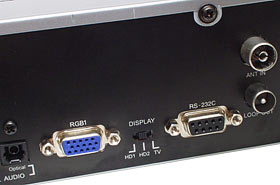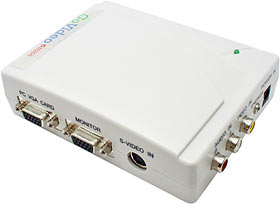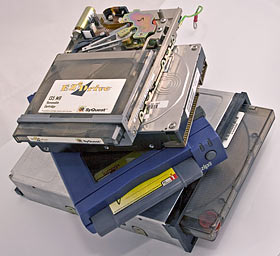
Atomic I/O letters column #59
Originally published in Atomic: Maximum Power Computing Reprinted here July 2006.Last modified 16-Jan-2015.
i-RAMpage
The Gigabyte i-RAM is one sexy piece of hardware. My question is simple, the solution is probably complex. Is there an automated way to backup the entire 4Gb onto a image file on a hard drive, say hourly? With the transfer rate of a SATA HDD, this wouldn't take too long. Problem is, if Windows is installed on the i-RAM, can it be done while still using Windows?
If this device can be made with an automatic image hourly its going to be worth every cent, as a restore would be quick as well.
Any help would be great and would sway my thoughts on where my next pay cheque (or two) is going.
Chris
Answer:
Norton Ghost version 9 and later (which is actually
a further developed version of PowerQuest Drive Image; Symantec bought PowerQuest and retired their own disk imaging
product) does indeed let you make image files from a system drive without restarting the computer. This feature was
originally called "Hot Imaging" and now doesn't seem to be called anything in particular, and it introduces some new
ways to screw stuff up that don't exist in the old-fashioned
DOS-based Ghost 2003, but it ought to do what you want.
Bear in mind, though, that overwriting the image file hourly will, despite DMA, significantly slow the system for the minute or three it takes. Which kind of defeats the purpose of getting a hyper-fast solid state disk in the first place, if you ask me. You may also transfer any of the screw-ups you're presumably trying to guard against to the image file before you know they exist.
Given this, if you're concerned about preserving the data on an unpowered i-RAM beyond the "up to 16 hours" that its built in battery provides, I'd suggest looking into bigger batteries. And, of course, making ordinary backups as normal.
Cutting edge displays
My father has an old Gravograph engraving machine that uses an RCA cable output that goes into a monitor similar to that used on an Apple IIe. He originally had a IIe monitor, but that has now died, and I'm wondering if you might happen to know how to make a converter which allows a standard 15" monitor cable to be connected to an RCA cable?
It would also make for great viewing of TV on a 21" Sony monitor!
Andrew

HDTV STBs commonly come with computer connections for super-sharp TV on a PC monitor...

...or you can use a video converter box. If you must.
Answer:
If it connected via RCA cable to an Apple monitor, then it's outputting composite video.
So you can just use a TV.
The reason why people didn't plug TVs into their Apple IIs in the first place was that TVs back then didn't have composite inputs. You had to use an RF modulator and tune the TV to it, as with the antenna output of a VCR, and the results weren't pretty.
Today, though, every TV has composite input, and even quite cheap models are PAL/NTSC compatible, so it doesn't even matter which of those two flavours of composite the engraver outputs. You should be able to just plug it in and go.
The engraver probably doesn't have high enough output resolution that you need a very sharp screen, either. The maximum resolution for an Apple II was 560 by 192 (Double Hi-Res, which only became possible with the release of the IIe).
The maximum practical resolution for ordinary TVs is 640 by 480, but few of them can really display that clearly. Since you probably don't have even that many pixels to worry about, though, you'll be fine.
If you really want VGA output, then you can get it; building your own converter box is less than trivial, but pre-built ones sell for not much more than a hundred Australian bucks.
But TV won't look any better on a computer monitor than it will on a decent TV, unless it's high definition in the first place. The way to get that is by buying a high definition Set-Top Box that already has VGA ("RGBHV") output.
More storage fun
I have a pair of WD 36Gb Raptor drives in RAID 0 configuration, on an MSI 875P Neo-FIS2R motherboard, using the onboard Promise controller. But one day they stopped working.
I thought that one hard disk might have failed, so because it was RAID 0 I wouldn't be able to recover any data at all. But I wanted to try disconnecting them and connecting them to the onboard Intel controller, with the right order for 1st and 2nd drive, and configure them as RAID 0 again, just to see if the problem might be with the Promise controller.
I would like to know if this is feasible, or if there is another way to recover the data on the drive. Or can I just kiss goodbye to all the data?
Alejandro

That's not a RAID problem. This is a RAID problem.
Answer:
Perhaps, in theory at least, you could set the drives back up in software RAID, if you use the same block size as
the previous controller was using. There's probably some magic cookie that needs to be added to the top of the drives,
though, which software RAID (or a different hardware RAID controller) won't believe is there until you repartition
the volume. But maybe it can be done.
Of course, you do not actually have any problem at all, because all of the data you value is backed up, right? I mean, you wouldn't have used a storage system that doubles your chance of a disk failure and still not made backups, right?
(After I put this page up, a reader mentioned RAID Reconstructor to me. It's a data recovery tool for broken RAID arrays. It won't help you if you've got a non-redundant array with one or more deceased drives in it - because then, every Nth bit is on the dead drive, and there's no way to get it back - but it could be useful for failed "proper" RAIDs.)
Speaks with forked fan cable
Can two separate fans be wired to a single three or four pin connector on the mobo - for instance two CPU fans?
Iron
Answer:
Yep, provided you don't exceed the current capacity of the connector.
Note that only one (or none) of the fans can have its yellow "tacho" wire connected, or you'll get very weird speed readings.
Sydney to Melbourne, via Darwin
If I have three computers connected to a network using a router and I want to transfer some files from computer A to computer B, does it matter whether I initiate this transfer using computer A or computer C, using Windows file sharing?
Basically, I just want to know whether if I use computer C to transfer the file from A to B, it has to go THROUGH computer C on the way (thus wasting processing time and network bandwidth), or if it just goes from A to B either way.
Chris
Answer:
Yes, it'll be inefficient if you copy data between shared folders from a computer on which neither of the folders
actually resides. Computer C will be sucking and blowing data, and the transfer will be slower.
If you use something like Remote Desktop or VNC to control one of the other computers from Computer C, though, you'll be able to tell that computer to initiate the transfer itself, without having to sit in front of it.
They did it in an episode of Stargate
I'd like a way to test my application's ability to handle Windows' 49.7 day rollover problem, but I don't want to wait 49 days.
Is there anything that can make a Windows system run fast? (Say, one second realtime equals one minute Windows time?) Overclock the clock itself?
Aaron
Answer:
A busted clock-skew setting will do it, as I mention here.
If you're trying to bring on the famous Win98 rollover crash bug, as opposed to the .NET one you mention, then I don't think that'll help, since I'm not sure that 98 even uses a skew setting. I'm also unhelpfully unsure about how to deliberately screw it up the skew setting in other Windows versions.
But it should be easy enough to write a little program that'll wedge itself between the system clock and everything else and provide freaky time output.
Give my creation... LIFE!
My mother gave me an APC "UPS" powerstrip with a dead battery. The battery is a bit expensive to replace.
It says it's 12V, four amp-hours (4000mAh). Is there any particular reason I couldn't just lengthen the wires and attach them to a spare car battery to get longer service out of it?
The power around here tends to go out a lot, and it'd be nice to keep my cable modem going while I use the laptop in the dark. I remember your Franken-UPS, and if this won't work I'll probably go with something like that, but easy is easy, right?
David
Answer:
Might work, might not. The charger may interpret a long charge time as a battery failure, or (less likely) may overload
when presented with the lower resistance of a much higher capacity battery; the standard battery is a quite small
one.
As I recently demonstrated, it's probable that you can add much bigger batteries to a mid-sized UPS with no trouble, and it's perfectly possible that the same thing (using just the one big battery, not two in series, since your little UPS is a 12 volt unit, not 24V) would work fine too. If you want to play it safer, any sealed lead acid battery of around the same capacity as the original is practically certain to work.
4Ah 12V "bricks" are a standard type (today they may be nominally 4.2Ah, or something; the capacity figures of various kinds of battery creep up over time, though it's open to debate whether the actual capacity does...), and you can buy them from various electronics stores. They should cost less than the stock battery. You'll still need the extension wires, though, because the cheaper batteries are a different shape.
It's also pretty much definite that a 12V 7Ah-ish SLA brick would also work; that's not much of a capacity jump. 7Ah batteries are the most commonly used SLA, and so they cost about the same as the 4Ah models. You can also get 4Ah-ish 6V batteries that're (for some reason) less than half the price of a 4Ah 12V; Two of those in series might be your cheapest option.
The heck with Media Center Edition
I've had my computer set up to output video to our TV and audio to our stereo for quite a while. However the image has always been a little flickery and liney. I've read that I need a couple of "baluns" in line, as video wants 75 ohms while the Cat5 cable I'm using is 100 ohm. Dick Smith has nothing of the sort, though.
What do you think? Are baluns of any use? And if so, how would I make one?
Eric
Answer:
Yes, you need 'em, but you don't have to make your own. Here in Australia,
Allthings Sales and Services (coincidentally previously linked to from this page, because I bought my video-to-VGA
box from them) have a selection of them, including the multi-plug versions that make it easier to move component video
over Cat5.
Baluns are just transformers, and you can wind them yourself on toroidal or straight cores in a variety of ways, but I don't know the exact ins and outs of the ones for video to Cat5. It's not just getting the turn ratio right to match the impedance; you also need to pick a core that'll give enough bandwidth.
So, if you ask me, it's easier to just buy the things, seeing as they're not terribly expensive.

